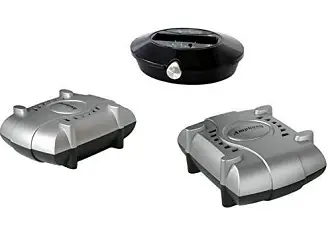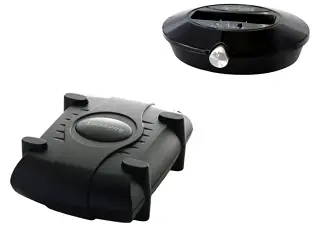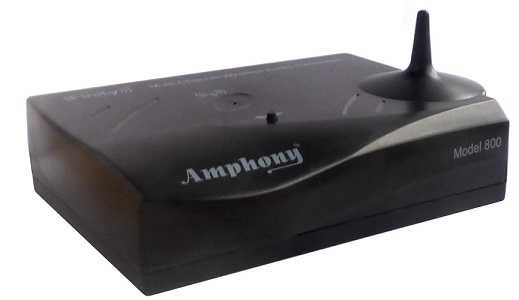Running cables to your speakers is not always the best idea. In fact, it can be a real nuisance or just not possible. The answer is to use a wireless speaker. However, these speakers come at a premium price that is not worth it for everyone.
But wait – There is a way to convert wired speakers into wireless speakers!
So, how to make speakers wireless? Well, this is done by using a wireless speaker converter kit. These kits work to make speakers wireless by sending the audio via radio-frequency (RF). As these kits typically do not provide power the speakers, you may need to use an amplifier too. Without further ado, let’s dive in!
Best Wireless Speaker Conversion Kit

1. Amphony Wireless Speaker Kit with 2 Wireless Amplifiers
Amphony is one of the most well-known brands in the market, and we can see why. They produce high-quality products that do that they are supposed to.
We have this new model in first position for a number of reasons. First, we like that wireless speaker kit for wired speakers comes with two amplifiers. Both of these amps have an impressive wattage power of 80. Pair these with a subwoofer and you’ll really be feeling the music!
We also love that the wireless speaker kit works well from long distances and doesn’t cause any static. In fact, you can place the unit is another room entirely.
Amphony claims the sound quality is comparable to class-D amps, which is something we have to agree with. You have the option to pair the kit with up to 4 wireless amplifiers, to really crank-up the sound.
The kit also has great power efficiency, which means it uses the majority of power that comes into the unit (90% to b precise). This number means that there is a low chance that the unit will overheat.
Overall, we believe that the Amphony Wireless Speaker Kit is the top kit on the market.

2. Amphony 1700 Wireless Speaker Kit
The Amphony 1700 is similar to the first kit in this review, but only with one amplifier. So, if two amplifiers are too much for you, then this would be our recommendation. Just like the first Amphony, this kit also comes with 80 watts of power.
This unit has linear frequency response, which means it is great at managing sound distortion and finding a good range.
Multi-room room capacity is also a great feature, especially to make surround speakers wireless. Users can use a maximum of four amplifiers with the unit, even though you only receive one as part of the kit.
As this wireless speaker kit is so similar to first one, we won’t repeat ourselves. Basically, if you just want one amplifier, we would recommend the Amphony 1700.

3. Rocketfish Wireless Home Theater Rear Speaker Kit
The Rocketfish Wireless Rear Speaker Kit communicates via radio-frequency to deliver a a great surround-sound effect. As such, this is great wireless speaker kit for home theaters.
You’ll receive a wireless receiver and wireless sender. This is a great wireless transmitter speaker kit, but it can only go to 100 feet, unlike the Amphony kits that can go 200 feet. Either way, 100 feet should be enough. The speaker kit also only has 25 watts of power, instead of the 80 watts that the Amphony kits have.
With that said, users will appreciate how easy it make wired surround sound speakers wireless. It works with any speaker that has speaker wires. It’s worth noting that the Rocketship kit is a wireless speaker kit for rear speakers, which means the sound will only be as good the speakers at the front.
To conclude, we prefer the Amphony speakers, but this is a good option to those who are on a budget
How Does a Wireless Speaker Kit Make Speakers Wireless?
Simply put, wireless speaker kits send the audio signal via a radio-frequency signal. You may notice that the kits come with two units, which are known as the transmitter and the receiver.
As you may have guessed, the transmitter “transmits” information to the receiver. The input is then processed by the receiving unit and then routed to the device that is connected.
You may need a third piece of kit, which is the amplifier. This is because most wireless speaker conversion kits don’t come with a built-in amplifier and you need one to power the kit. Even if the kit does come with a built-in amplifier, it will likely be very weak. Buying another amplifier will give the best result.
Please mot that the radio-frequency operates on the same signal that your Wi-Fi uses. As such, the router may cause interference with your kit.
How to Set-Up a Wireless Speaker Kit
1. Choose a Wireless Speaker Kit
When choosing the best wireless speaker converter kit, you have a choice between a kit with no built-in amplifier or a kit with a built-in amplifier.
From our personal experience, we recommend using a wireless speaker kit with no built-in amp. You may be surprised by this choice, but this is because most wireless receiving units don’t have much power.
Make a note of the outputs available on your A/V receiver and the inputs on the transmitting unit. Receivers that have pre-outs can be connected to RCAs to the transmitting unit.
However, not all receivers have pre-outs. If yours doesn’t, then make sure that wire can be used as an input for the receiver. You also have the option to use a line-level adapter, which works to convert speaker leads to RCAs.
2. Connect the Transmitter
After finding your perfect wireless speaker kit for your exact needs, you can start the process of converting regular speakers into wireless speakers.
The first step is to connect the transmitter with the amplifier or receiver. Using radio-frequency, the transmitter is able to send audio wirelessly. Your options will depend on the exact kit you purchase. On the transmitter you’ll find a RCA, speaker wire, and 3.5mm Aux input.
When talking about speaker wire inputs, you should connect the speaker wire from the outputs to the inputs on the transmitter. RCA inputs are connected from the receiver pre-outs to the transmitter’s RCA inputs.
There’s a chance that your transmitter only has a 3.5mm input. If so, it’s important to own a “RCA to 3.5mm adapter”, which will allow you to connect to the transmitter. Once you have connected the inputs for the transmitter, it’s just a simple case of plugging the AC power adapter into the transmitter and the power outlet.
3. Connect the Receiver
To make regular speakers wireless, we now need to connect the wireless receiver. Now, these steps will vary depending on which kit you own. Here are the various methods:
Separate amplifier – If your kit doesn’t come with a built-in amplifier, and you’re using a separate one, you should connect RCAs to the amplifier from the receiving unit. You then need to connect the amplifier to the speaker with the speaker wire. This set-up sees the amplifier receive signal from the receiver, and then the amplifier works to ramp-up that signal to the speakers. The receiving unit provides the signal to the amplifier, and then the amplifier applies power to that signal and sends it to the speakers.
Built-in amplifier – Although unlikely, there is a chance that your receiving unit has a built-in amplifier. If so, the connections are super simple. All you have to do is connect the wires from the speaker to the receiving unit, and then provide power to the receiver. Again, we don’t recommend using this method as it doesn’t give a powerful or loud sound.
Speakers that contain an amplifier – You may own speakers that use an internal amp as a power source. This type of speaker only needs an audio source to produce a sound. In this case, you won’t need an amplifier. It’s just a case of connecting the speaker to the receiving unit’s RCAs.
4. Test it
Now that you’re all set-up, you need to test it out.
The first step is to ensure that there is a strong signal between the receiver and the transmitter. A big clue that this is not the case is if the speaker sound is unclear or delayed. If so, try moving the position of the transmitter or receiver.
As with all technology, you should make sure the cables are plugged-in properly and on the correct channel. Transmitters usually have a number of different channels, so change between them to see if the sound quality improves.
Once you’re happy with the signal, you may want to adjust the sound levels on the speakers, although the sound should be similar on both wireless and wired speakers. You can adjust the volume levels on the amplifier, receiving unit, or both.
Conclusion
As you can see, it’s relatively easy to convert wired speakers to wireless! All you need is a wireless speaker kit and some knowledge of how to best set it up.
Hopefully, this article has helped you to learn how to make a speaker wireless and how to find the best wireless speaker converter kit. If you don’t want to mess around trying to convert wired surround speakers to wireless, you can always get yourself a wireless speaker system, although they aren’t cheap!
With that said, we recommend using a wireless speaker kit to make any speaker wireless, as it’s pretty simple to set-up and you will be surprised at the positive result.
